Seaweed farms on both coasts are beginning to take hold, tapping into decades of painstaking science, and could help shellfish thrive in waters affected by climate change and pollution.

Seaweed farms on both coasts are beginning to take hold, tapping into decades of painstaking science, and could help shellfish thrive in waters affected by climate change and pollution.
June 27, 2024
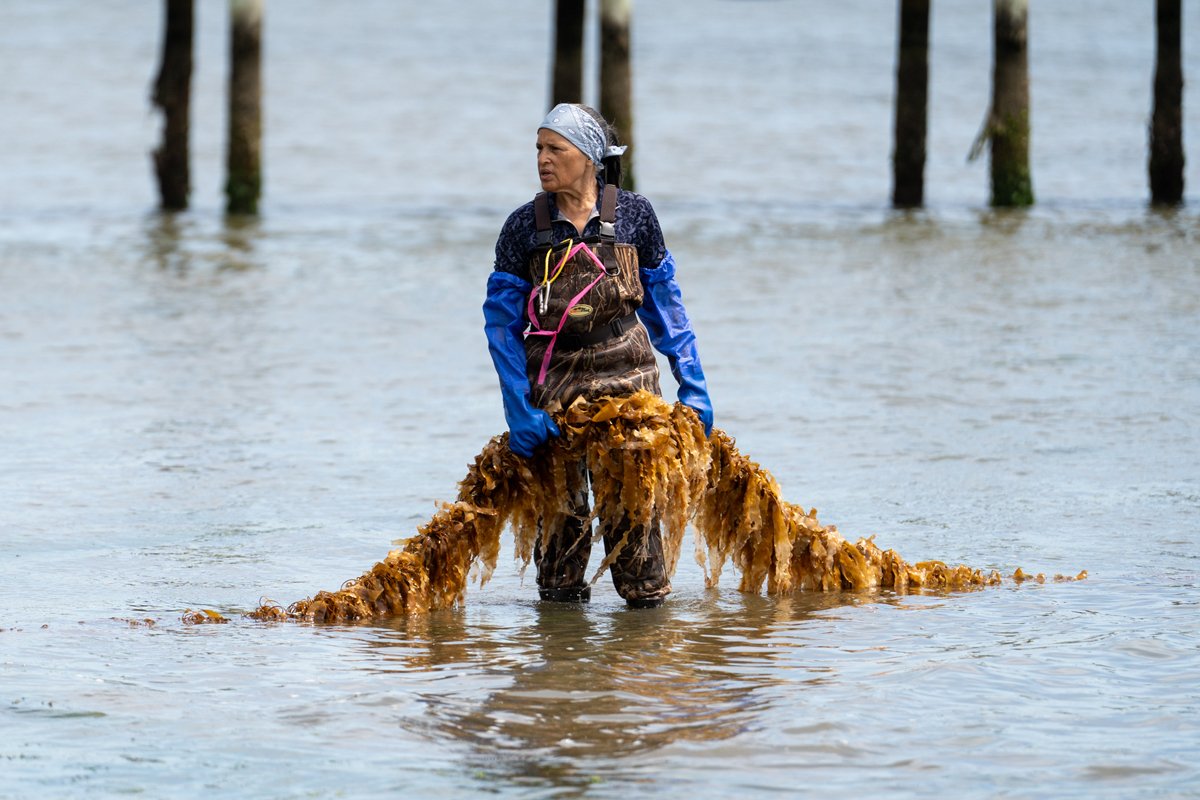
Donna Collins-Smith hauls out kelp lines for the Shinnecock Kelp Farmers on Shinnecock Bay. (Photo credit: Rebekah Phoenix)
Rebecca Genia walks out into Shinnecock Bay at low tide with a few of her great-grandchildren, using her feet to find hard-shelled quahogs buried in the sand. As a kid, she could fill a trash can with the blue-lipped mollusks in less than an hour—and could also gather other shellfish like oysters, mussels, or scallops, depending on the season.
Now, she says, “it takes us a while to even get a couple of dozen clams. That’s not right.” She points out that most of the shellfish she harvests these days have been seeded manually by the town of Southampton and local universities, “almost like a science project,” she says. “The natural way has been contaminated and polluted by mankind.”
What’s also not right: the quality of the quahogs. “The shells are so brittle,” she says. The increasingly acidic water in the bay makes it hard for the clams to build strong shells. She points to her necklace of wampum—mollusk-shell beads that are integral to Eastern Woodland Native American culture. Hers is a single large indigo-and-white pendant, half an inch thick, the way shells used to be.
Genia, a member of the Shinnecock Nation, has lived along these waters on the South Fork of Long Island, New York, for most of her life. Shellfish are a traditional food source for the Shinnecock; they were also once the backbone of Long Island’s robust commercial fishing industry. Her tribe witnessed the crash of the clam and scallop fishery in the 1990s and then another crash in the 2000s, which further depleted shellfish stocks and threatened the nascent farmed oyster industry. Both were caused by massive blooms of harmful algae.
In 2020, after watching the decline of Shinnecock Bay—a body of water that has fed her tribe for some 13,000 years—Genia worked with Tela Troge, a tribal lawyer, to form the Shinnecock Kelp Farmers, a group of five Indigenous women who grow kelp to fight climate change. The group hopes to heal their afflicted bay and inspire a new generation to adopt more regenerative practices on the water. “We want our children to be able to go out there and clam and collect oysters and scallops and mussels like we used to,” says Genia. Plus, Shinnecock women are water protectors, she says, and being out on the bay is “in our DNA.”
Recent scientific studies show that as the ocean becomes unfriendly for shellfish, seaweed could offer a solution—in particular, the large brown algae called kelp.
The women’s move toward seaweed as a solution is emblematic of a shift across the country as the world’s oceans change faster than scientists ever expected. Since the 1990s, ocean acidification—caused by more carbon in the atmosphere dissolving into the sea, among other factors—has increased at alarming rates; in the U.S., the West Coast is especially impacted. Increased acidification means crustaceans in their critical larval stage cannot pull enough calcium carbonate from the water to create shells.
By 2015, acidification had become so significant globally that the United Nations addressed the crisis as part of its Sustainable Development Goal 14: Life Below Water. Their guidelines have spurred government investment, university research, and private interest to tackle acidification ever since.
Nitrogen-rich wastewater, another byproduct of rapid human development, feeds huge blooms of algae (known as “red tides” or “brown tides,” depending on the species) that starve other marine life of oxygen. Some algal blooms produce toxins that make shellfish unsafe to eat. The blooms are a particular problem in shallow waterways like Shinnecock Bay.

Volunteers help to hand-harvest the Shinnecock Kelp Farmers 2023-2024 sugar kelp haul on New York’s Shinnecock Bay. (Photo credit: Rebekah Phoenix)
These twin phenomena of acidification and algal blooms are deadly for all crustaceans, including shellfish. And they can spell disaster for coastal communities, as 3 billion people globally rely on “blue foods” from the ocean, including shellfish, as a primary source of protein.
But recent scientific studies show that as the ocean becomes unfriendly for shellfish, seaweed could offer a solution—in particular, the large brown algae called kelp. Wild kelp forests form the most extensive marine-vegetated ecosystems in the world. They grow on every continent except Antarctica and provide habitat and food for the ocean’s smallest creatures to its largest.
Rich in minerals, kelp grows quickly and doesn’t require fertilizer. It isn’t seriously affected by acidification or algal blooms, and in some cases, it can even mitigate their impact on shellfish, because kelp soaks up excess nutrients like nitrogen and increases oxygenation in the waters around it. What’s more, the fibrous plant, which can grow two feet a day, also pulls anywhere from five to 20 times more carbon from the atmosphere than any terrestrial crop, something that leading marine scientists are working to quantify right now.
Because of these beneficial properties, kelp is being hailed as a miracle, a panacea for the climate crisis. Scientists, coastal governments, and private industry alike think it could be the cornerstone of a new, blue economy that allows coastal communities in the United States to transition from extractive industries into more sustainable ones.
Bolstered by roughly $380 million in investments since 2018, kelp farmers have proliferated from around zero in 2012 to 108 active farms in 2023, according to Connecticut Sea Grant, part of a national network of university-based programs dedicated to encourage stewardship of marine resources. Seaweed farming, a longstanding tradition in Asia for more than a hundred years, is now gaining a place on U.S. shores.
The science behind this boom in seaweed cultivation began in New England nearly 50 years ago.
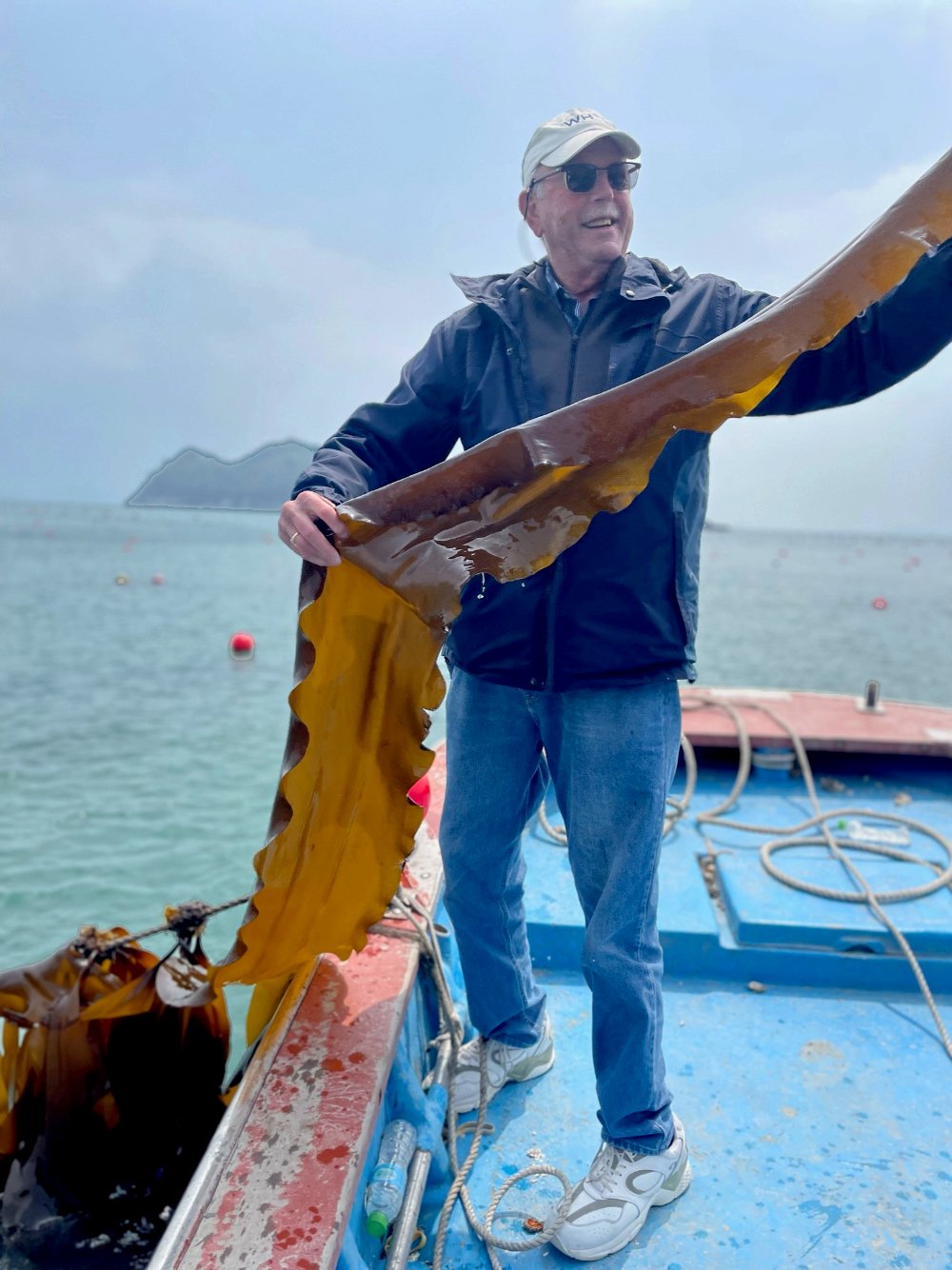
Charles Yarish holding Saccharina japonica seaweed offshore of Wando, South Korea, in 2023. (Photo courtesy of Charles Yarish)
Charles Yarish, now a visiting scientist at the Woods Hole Oceanographic Institute in Massachusetts, is considered the father of American seaweed farming. Gregarious and welcoming, Yarish can talk kelp nonstop. In 1976, as a new assistant professor at the University of Connecticut’s Department of Ecology and Evolutionary Biology and also its Department of Marine Sciences, Yarish became increasingly fascinated by kelp’s ability to pull nutrients from the water column. He suspected that farming kelp and other seaweeds could help alleviate water quality issues.
Toiling away at his Connecticut laboratory and conducting experiments in the Long Island Sound, Yarish spent the next few decades proving this hypothesis, focusing mostly on how kelp can pull nitrogen from waterways. “The farming of seaweeds such as kelp not only has business applications but is terribly important for ecosystem services, removing [excess] nutrients from ocean waters and lowering pH,” he explained.
Those early studies have impacted the growth of mariculture studies globally. At UConn, Yarish established an internationally known Seaweed Marine Biotechnology Laboratory, and was tapped to advise the Department of Energy’s current MARINER Program, which has invested $66 million in seaweed aquaculture since 2018.
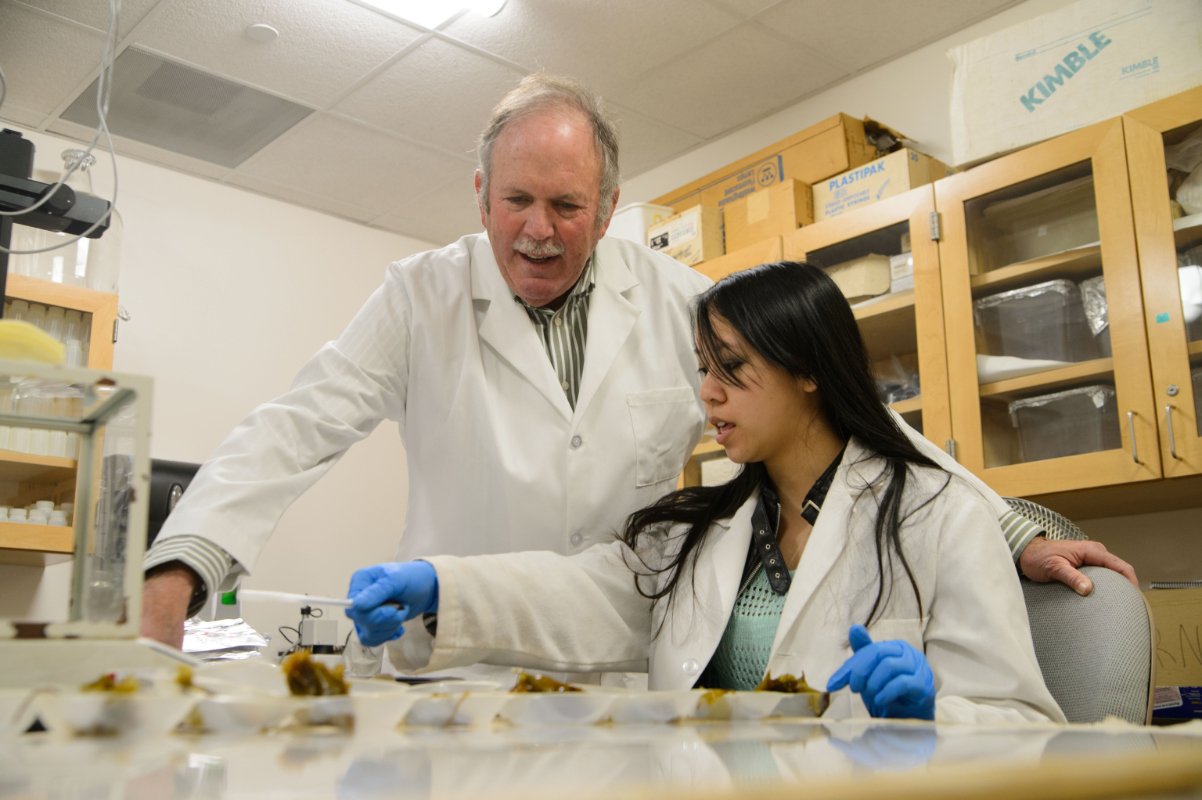
Charles Yarish looks over recently collected kelp with a student in a lab at the Stamford campus in 2013. (Photo credit: Peter Morenus, University of Connecticut)
In 2016, scientists in Maine, alarmed by their state’s warming waters and increasing acidification, and inspired in part by Yarish’s early work, began studying whether kelp could provide a sanctuary for shellfish. Using the country’s first-ever commercial kelp farm in Casco Bay and funded by a constellation of government, nonprofit, and academic groups, the effort was led by Nichole Price and her team at the Bigelow Laboratory for Ocean Sciences.
After three years, they determined that co-growing blue mussels with sugar kelp—Saccharina latissima, the go-to variety of farmed seaweed for colder North American waters—led to increased oxygenation in the water. The scientists also documented kelp’s ability to locally raise seawater pH, which allowed the mussels to build thicker shells despite the acidic waters.
Price dubbed this the “halo effect” of kelp. She plans to continue monitoring outcomes to see how farms will fare in the future, since Maine’s waters are predicted to be too acidic for shellfish to calcify for most of the year by 2030.
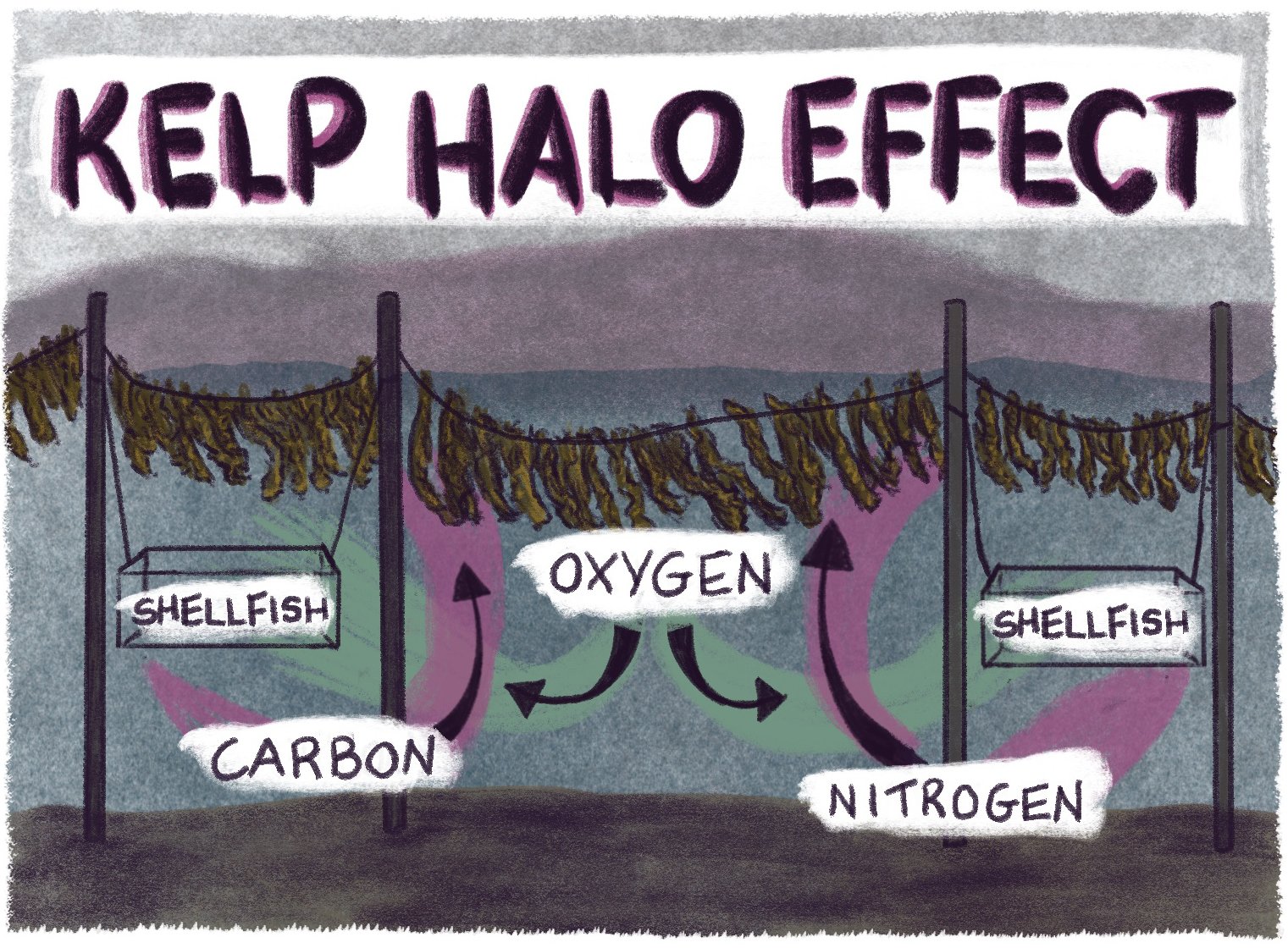
An illustration showing the kelp halo effect, how it can absorb carbon and nitrogen and release oxygen to support shellfish growth. (Illustration credit: Nhatt Nichols)
Price said evidence is growing to support the idea that co-growing shellfish and seaweeds can offset the impact of climate change. The scientific field is tackling some big questions that could benefit the kelp farming industry. Including, she said, “Is it a consistent halo effect, or is it only in these protected bays? Or does it depend on the size of the kelp farm? If it’s a really big kelp farm, can it still create a halo even in exposed areas?”
While scientists race to understand the best growing methods for seaweeds with shellfish, the co-growing concept has been widely marketed by Bren Smith of GreenWave, who was first introduced to kelp by Yarish in 2013, after Smith’s oyster farms on Long Island Sound were decimated by hurricanes. Smith’s brand of co-growing focuses on a polyculture ocean farming model that combines shellfish with seaweed, an idea that he propagated in a book, Eat Like a Fish, and in GreenWave’s instruction manuals for “regenerative ocean farming,” which the group said thousands have used.
Although scientists on both coasts are still studying the effects of co-growing kelp with shellfish species like oysters—which fetch higher market value but generally grow in different environments than kelp—Smith promoted the idea of growing shellfish and oysters together, and is widely known in the industry for popularizing this approach.
“We’ve learned the seaweeds can inhibit harmful algal bloom and even represent a direct food source for the bivalves as they slough off microbial cells.”
Growing shellfish alongside seaweeds or finfish is a practice long used in Asia, especially China. However, it has been slower to catch on in the U.S., in part because of the lack of trials here. Inspired by the Asian approach and by Price’s work in Maine, in 2018 marine scientist Chris Gobler began focusing on kelp’s potential to heal his local waterways in New York, where algal blooms posed a bigger threat than acidification.
Eastern Long Island in particular was burdened with aging, failing septic systems that leached nitrogen into groundwater and ponds, lakes, rivers, streams, and bays. That excess nutrient runoff, combined with warmer waters, essentially fertilized the growth of harmful algal blooms yet again that year. Large swaths of open water were closed to shellfish harvesters by the New York State Department of Environmental Conservation.
Although Price was studying the co-raising of kelp with mussels to offset acidification, there was no scientific evidence yet to show how kelp could help shellfish during algal blooms. Gobler, working out of Long Island’s Stony Brook University laboratory, thought that kelp might benefit oysters. Aided by Michael Doall, a former commercial oyster grower–turned scientist who’d devised a way of growing kelp in shallow waters, Gobler launched a three-year study in 2019, hoping to find a solution for Long Island’s troubled waters that could be applied on both coasts.
By 2022, he had his answer: “We’ve learned the seaweeds can inhibit harmful algal bloom and even represent a direct food source for the bivalves as they slough off microbial cells.”
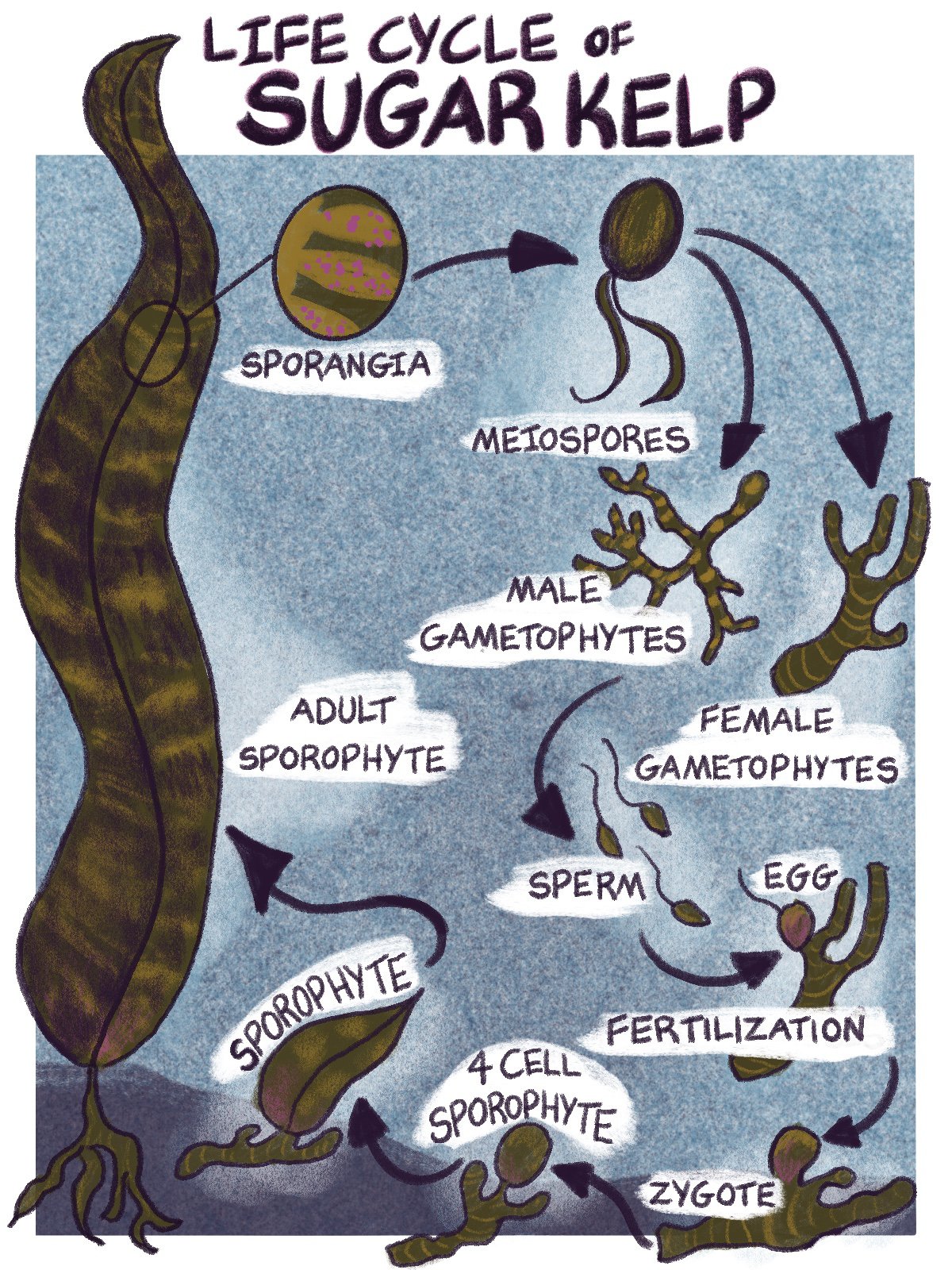
An illustration of the life cycle of sugar kelp, showing how it grows and develops over time. (illustration credit: Nhatt Nichols)
What’s more, Gobler’s lab had proved that raising kelp with oysters led to faster-growing, healthier shellfish. Gobler dubbed the phenomena the “halo effect”—a nod to Price’s studies—noting that the kelp around oyster cages provided a “halo” of increased oxygenation to the oysters as the kelp grew. At the same time, the kelp removed excess nitrogen from the water column. Backed by Gobler’s studies and studies from Price at Bigelow Labs in Maine, the idea of raising shellfish with kelp is now spreading across the country, including to the West Coast, where acidification is even more pronounced.
In 2018, seaweed experts believed that sugar kelp, a large brown seaweed with furled, silky tendrils, could only be farmed at depth—as it was in Maine, the center of the seaweed industry. If sugar kelp could only grow in deep water, it couldn’t be deployed for oyster farms, which are often tucked into shallower nooks of rocky coasts or set up in shallow bays.
Michael Doall, a scientist at Gobler’s laboratory, solved the problem. A former oyster grower, he saw the business potential for a crop that not only had ecosystem benefits but could be harvested in winter, opposite the main harvesting time of summer for oysters—providing two income streams from the same patch of water.
To pave the way for a kelp-meets-oysters business model that would work on Long Island, Doall decided to try growing kelp in shallower waters. In December 2018, accompanied by oyster farmer Paul McCormack, Doall began an experiment on Long Island’s Great South Bay. The two men sank metal screw anchors into the sandy sea floor and strung long nylon lines, inoculated with kelp spores, between them. And then they waited.
Over the next few months, the kelp not only grew, but outperformed their predictions. Doall and McCormack were ecstatic. “It worked really freaking great,” recalled Doall. Gobler, using the findings, then put sugar kelp to work in his breakthrough kelp-and-oyster co-raising study.
Using Doall’s growing techniques and the science from Yarish and Gobler’s laboratories, at least 10 sites across New York are now using sugar kelp to pull excess nutrients out of the waterways. They are also collaborating on a recently proposed $700 million project at Governor’s Island that relies in part on seaweed farming to help prepare New York City for climate change.
Although seaweed grown as a bioremediation strategy cannot be used for human consumption—in some cases, as with RETI Center’s project in the Gowanus Canal, the kelp harvested showed high traces of polycyclic aromatic hydrocarbons (PAHs), a known carcinogen—scientists are experimenting with other potential uses for it, such as a kelp-based concrete.
The first group to raise seaweed using Doall’s shallow-water technique were the Shinnecock Kelp Farmers. In 2020, led by Tela Troge, the women began growing kelp in the bay that surrounds Shinnecock Tribal Territory Nation, roughly 900 acres of low-lying sandy land. For millennia, the tribe has lived, fished, and harvested shellfish on this bay. Mitigating climate change and rising water is crucial to their survival, and seaweed offers a way to do that.
“We are a frontline community and we have nowhere else to go,” said Danielle Hopson Begun, communications director and hatchery manager for Shinnecock Kelp Farmers. Hopson Begun is equally comfortable out on the bay or giving public talks, where she spreads the climate-saving mission of the group.
“When you’re hearing on the news about sea rise and acidification and you’re able to move yourself from Southampton Village to higher ground—good for you. It is not good for us,” Hopson Begun said. “For us, it [is] a moral imperative to preserve our way of life.”
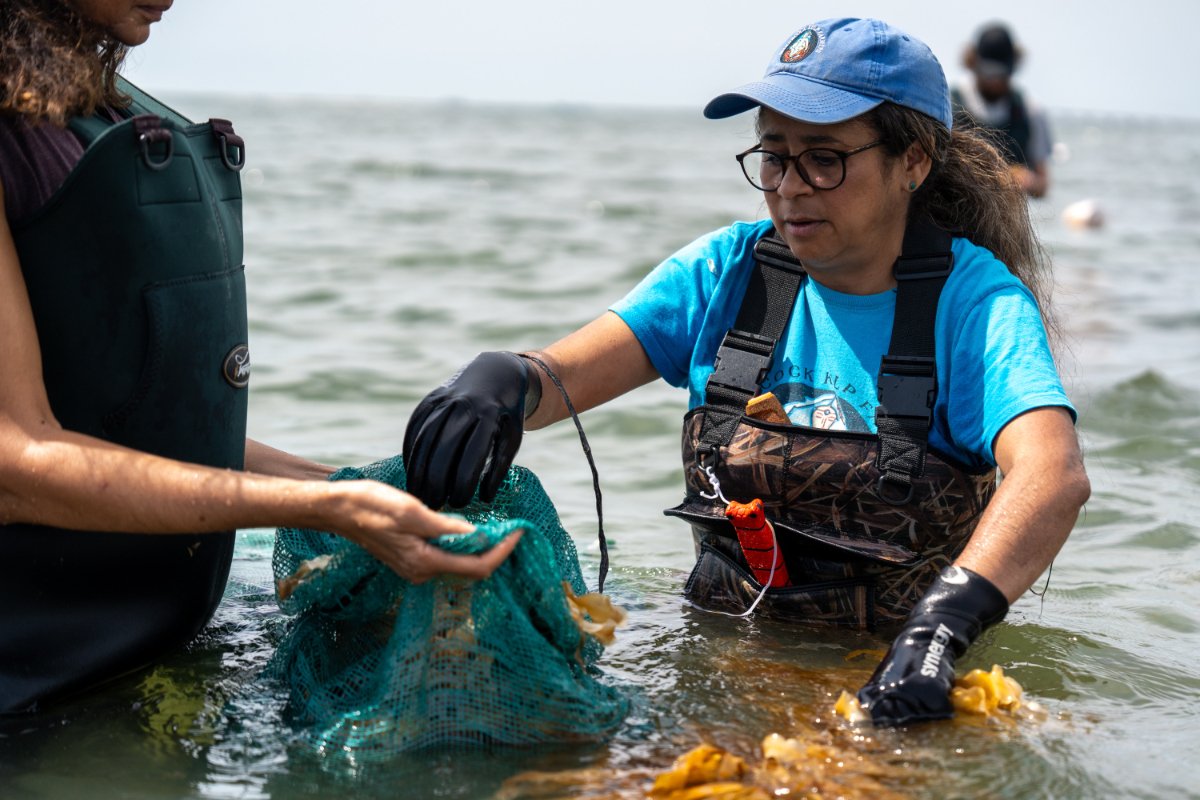
Danielle Hopson Begun hand-harvesting kelp in New York’s Shinnecock Bay. (Photo credit: Rebekah Phoenix)
To start their nonprofit, Shinnecock Kelp Farmers worked with GreenWave and Doall, who provided sorus tissue, the reproductive area of the kelp blade, for propagation. They found a home for their hatchery in a wooden cabin at the nearby St. Joseph’s Villa, a summer retreat for nuns. The wooded estate overlooks Shinnecock Bay, which now holds their kelp lines. For the 2023-2024 season, the farmers planted 30 lines at 100 feet each, a crisscross of golden-brown algae ribbons dancing beneath the water. As a sovereign nation, the Shinnecock did not need New York State’s permission to begin farming, and in 2020, they became the first seaweed growers in the state.
The group dries and processes their kelp by hand, turning the slippery curls of seaweed into hundreds of pounds of nitrogen-rich soil amendment that they use for gardening, sharing it with the local community at farmers’ markets. They lay the kelp out in donated screens, or along the pool fence at St. Joseph’s Villa, first washing the salt off the seaweed and then waiting for the sun to bake the kelp down.
Eventually, the heat crumbles the kelp into a dry, brown powder that plants love. Through this process, the nitrogen sequestered from the water column returns to the soil, a closed-loop nitrogen cycle now in vogue with organic farmers—although Shinnecock have been growing crops using seaweed as fertilizer for thousands of years, said Hopson Begun. Seeing the decline of seaweed in the bay in recent years, and knowing its benefits to shellfish, prompted them to start farming seaweed themselves.
While satisfying, the work is demanding, sometimes requiring the women to get up and work in frigid waters at dawn. For a recent November planting, they waded into 38-degree water during the first snow of the season, unspooling their kelp string as a hushed snow fell. But Hopson Begun wouldn’t trade it for anything. She said, “I love seeing something so small grow into something really incredibly powerful that potentially can make a big difference.”
On the West Coast, nitrogen pollution poses less of a problem, a benefit of the Pacific coast’s deeper water and colder ocean temperatures. But acidification episodes are much more acute here than in the East: Since the 1990s, it’s been rising precipitously, owing to a combination of increased carbon in the atmosphere and upwellings of deep waters that are rich in nutrients, but also relatively acidic. Many shelled creatures have been suffering as a result, unable to form thick, protective shells.
In 2007, this reached a crisis: Oyster businesses were devastated up and down the West Coast because baby bivalves simply could not grow.

Visualization: Alexander F More, University of Massachusetts/Harvard. (Data source: NOAA, Jiang et al. 2023)
“When it came time for our [oyster seed] orders to come in, the hatchery said, ‘We had a complete crash. If anything survived, we are going to be supplying our own farms, not you,’” recalled Terry Sawyer, co-founder of Hog Island Oyster Co., a Northern California favorite for its shellfish-focused restaurants. “We were sitting there, flapping in the wind.”
Trained in marine biology, Sawyer is an entrepreneur and lifelong ocean lover. When he and his co-founder, John Finger, realized how catastrophic the situation was, it spurred them to embrace a whole new outlook on marine conservation. Hog Island now regularly hosts marine scientists to study the effects of warming waters on nearby marine life. The company also collaborates with the Central & Northern California Ocean Observing System, providing real-time data from their farm on ocean acidification as part of a global effort to understand why the ocean is changing so fast.
Acidification led Hog Island, based on Tomales Bay, just north of San Francisco, to establish their own hatchery further north in Humboldt Bay, so they could ensure their whole line of production, from larvae to finished oyster. The process took about three years, and cost $125,000 in permitting fees alone, paid to the California Coastal Commission. Sawyer said the decision was the only way they’ve survived a situation that is cyclical for West Coast waters. Hog Island buffers the water at their hatchery by adding soda ash to make intake seawater less acidic, allowing the larvae to grow. The technique is now common practice; West Coast farmed bivalves cannot grow in the open ocean anymore.
“I love to say, ‘If we have a problem, we have to figure out how to eat it,’” said Sawyer, pointing out that seaweeds are a “winner” crop if ocean acidification continues to rise. “We are going to need to look at organisms that aren’t as impacted by pH change.” For now, though, Sawyer has to wait to unfurl kelp lines in Humboldt Bay, as the California Coastal Commission has no regulatory process for inshore commercial seaweed operations.
Instead, Hog Island has been collaborating with GreenWave and The Nature Conservancy on a non-commercial research pilot study since 2021, growing bull kelp at the Hog Island hatchery in Humboldt Bay. The waters are notably less acidic near the kelp lines—a promising result as the Hog Island team waits for California’s permitting structure to change for a commercial kelp farm.
Tessa Hill, a professor of marine science at U.C. Davis and author of the book At Every Depth: Our Growing Knowledge of the Changing Oceans, has dedicated her life to understanding how climate change is affecting the ocean. Hill conducted a study in Tomales Bay and found that seagrass “meadows” there also offset acidification, and could increase shell growth by up to 40 percent. She sees the same value in seaweed. “There is a lot of potential for co-culture of seaweeds and shellfish” in the bay, she said.
However, wild West Coast seagrass meadows and kelp forests are declining, and that makes Hill very worried. Subjected to stress from marine heat, acidification, pollution, predation by sea urchins, and human encroachment, these water-based ecosystems may lose their power to help fight ocean warming. “The more we protect habitats like seagrass meadows and salt marshes, the better chance we have at climate mitigation,” said Hill. She sees promise in seaweed farming for the same reasons.
Helpful marine organisms—like sugar kelp, bull kelp, and seagrass—could help reduce some of the worst climate impacts that scientists are documenting on the U.S. coasts. Raised in quantity, they could bring at least some stretches of shoreline back into balance, allowing marine life to thrive again in our waters.
The Shinnecock Kelp Farmers are starting to see it happen, bit by bit. “The most darling was a little tiny scallop that took up space on one of our lines. They’re endangered,” said Danielle Hopson Begun. “To see that little guy holding to and finding a place in our farm was very satisfying.”
This series was produced in partnership with the Pulitzer Center’s Ocean Reporting Network.

September 4, 2024
By paying top dollar for milk and sourcing within 15 miles of its creamery, Jasper Hill supports an entire community.
September 3, 2024

August 27, 2024

August 26, 2024

August 20, 2024

August 13, 2024
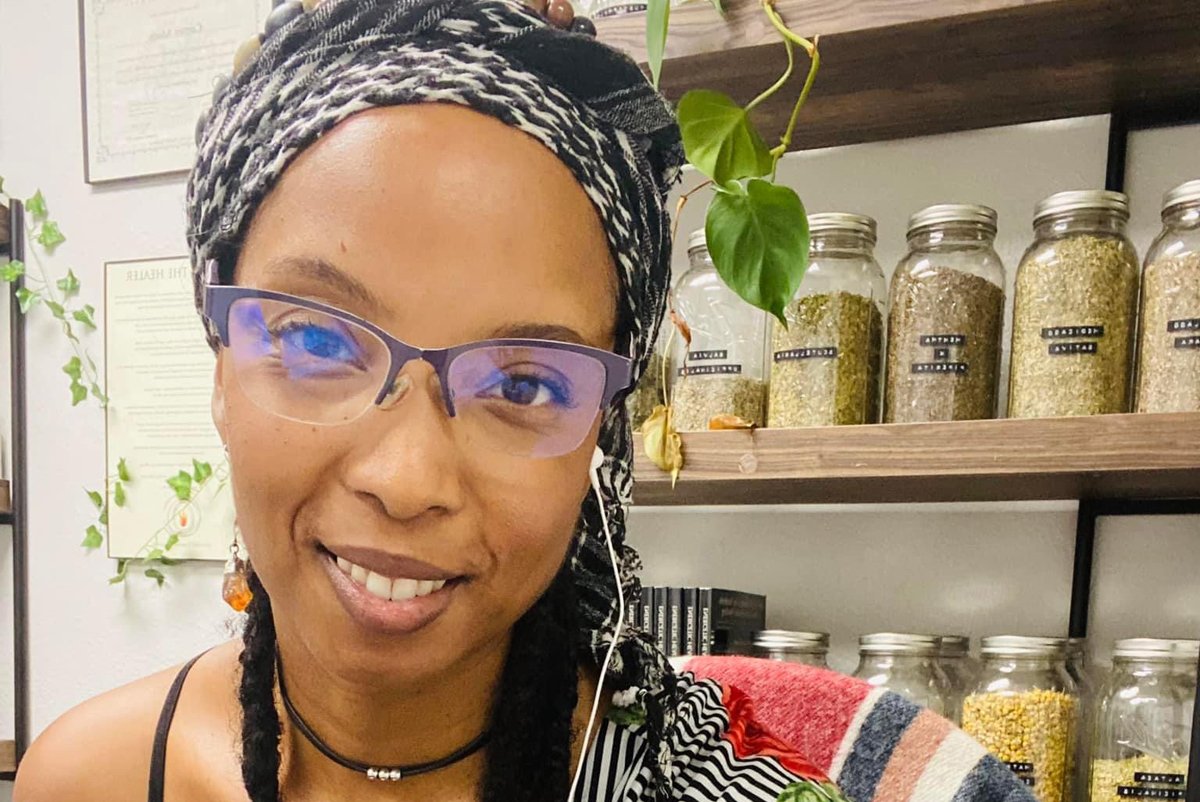
August 12, 2024

Like the story?
Join the conversation.